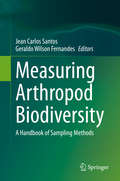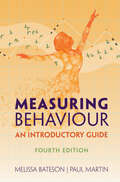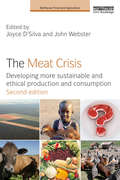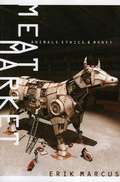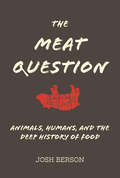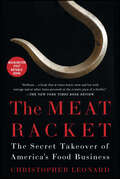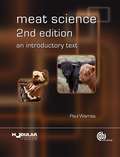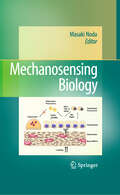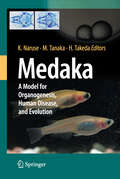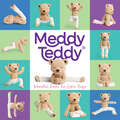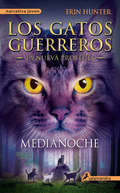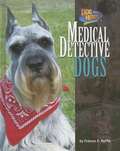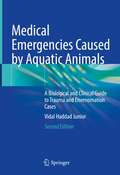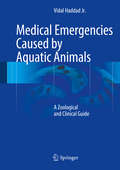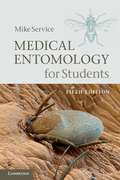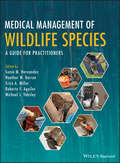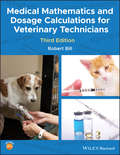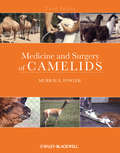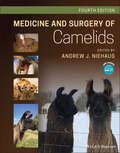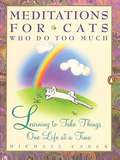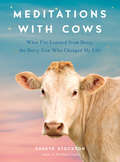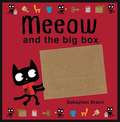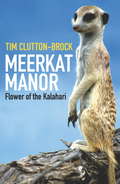- Table View
- List View
Measuring Arthropod Biodiversity: A Handbook of Sampling Methods
by Jean Carlos Santos Geraldo Wilson FernandesThis book brings together a wide range of sampling methods for investigating different arthropod groups. Each chapter is organised to describe and evaluate the main sampling methods (field methods, materials and supplies, sampling protocols, effort needed, and limitations); in addition, some chapters describe the specimen preparation and conservation, species identification, data collection and management (treatment, statistical analysis, interpretation), and ecological/conservation implications of arthropod communities. The book aims to be a reference for zoologists, entomologists, arachnologists, ecologists, students, researchers, and for those interested in arthropod science and biodiversity. We hope the book will contribute to advance knowledge on field assessments and conservation strategies. Arthropods represent the most speciose group of organisms on Earth, with a remarkable number of species and interactions still to be described. These invertebrates are recognized for playing key ecological roles in terrestrial, freshwater and marine ecosystems. Because of the increasing and relentless threats arthropods are facing lately due to a multitude of human induced drivers, this book represents an important contribution to assess their biodiversity and role in ecosystem functioning and generation of ecosystem services worldwide.
Measuring Behaviour: An Introductory Guide
by Melissa Bateson Paul MartinMeasuring Behaviour is the established go-to text for anyone interested in scientific methods for studying the behaviour of animals or humans. It is widely used by students, teachers and researchers in a variety of fields, including biology, psychology, the social sciences and medicine. This new fourth edition has been completely rewritten and reorganised to reflect major developments in how behavioural studies are conducted. It includes new sections on the replication crisis, covering Open Science initiatives such as preregistration, as well as fully up-to-date information on the use of remote sensors, big data and artificial intelligence in capturing and analysing behaviour. The sections on the analysis and interpretation of data have been rewritten to align with current practices, with advice on avoiding common pitfalls. Although fully revised and revamped, this new edition retains the simplicity, clarity and conciseness that have made Measuring Behaviour a classic since the first edition appeared more than 30 years ago.
The Meat Crisis: Developing more Sustainable and Ethical Production and Consumption (Earthscan Food and Agriculture)
by John Webster Joyce D'SilvaMeat and dairy production and consumption are in crisis. Globally, 70 billion farm animals are used for food production every year. It is well accepted that livestock production is a major contributor to greenhouse gas emissions. The Food and Agriculture Organization of the United Nations (FAO) predicts a rough doubling of meat and milk consumption in the first half of the 21st century, with particularly rapid growth occurring in the developing economies of Asia. What will this mean for the health and wellbeing of those animals, of the people who consume ever larger quantities of animal products, and for the health of the planet itself? The new edition of this powerful and challenging book explores the impacts of the global growth in the production and consumption of meat and dairy, including cultural and health factors, and the implications of the likely intensification of farming for both small-scale producers and for animals. Several chapters explore the related environmental issues, from resource use of water, cereals and soya, to the impact of livestock production on global warming and issues concerning biodiversity, land use and the impacts of different farming systems on the environment. A final group of chapters addresses ethical and policy implications for the future of food and livestock production and consumption. Since the first edition, published in 2010, all chapters have been updated, three original chapters re-written and six new chapters added, with additional coverage of dietary effects of milk and meat, antibiotics in animal production, and the economic, political and ethical dimensions of meat consumption. The overall message is clearly that we must eat less meat to help secure a more sustainable and equitable world.
Meat Market: Animals, Ethics, and Money
by Erik MarcusMeat Market elevates the debate over animal agriculture. Erik Marcus exposes and clears away the exaggerated claims and counterclaims put forth by the meat industry and its opponents. In the process, Marcus presents a thorough examination of animal agricultures cruelties and its far-reaching social costs. Marcus then considers the discouraging progress made by the animal protection movement. He evaluates where the movement has gone wrong, and how its shortcomings could best be remedied.
The Meat Question: Animals, Humans, and the Deep History of Food (The\mit Press Ser.)
by Josh BersonA provocative argument that eating meat is not what made humans human and that the future is not necessarily carnivorous.Humans are eating more meat than ever. Despite ubiquitous Sweetgreen franchises and the example set by celebrity vegans, demand for meat is projected to grow at twice the rate of demand for plant-based foods over the next thirty years. Between 1960 and 2010, per capita meat consumption in the developing world more than doubled; in China, meat consumption grew ninefold. It has even been claimed that meat made us human—that our disproportionately large human brains evolved because our early human ancestors ate meat. In The Meat Question, Josh Berson argues that not only did meat not make us human, but the contemporary increase in demand for meat is driven as much by economic insecurity as by affluence. Considering the full sweep of meat's history, Berson concludes provocatively that the future is not necessarily carnivorous.Berson, an anthropologist and historian, argues that we have the relationship between biology and capitalism backward. We may associate meat-eating with wealth, but in fact, meat-eating is a sign of poverty; cheap meat—hunger killing, easy to prepare, eaten on the go—enables a capitalism defined by inequality. To answer the meat question, says Berson, we need to think about meat-eating in a way that goes beyond Paleo diets and PETA protests to address the deeply entwined economic and political lives of humans and animals past, present, and future.
The Meat Racket: The Secret Takeover of America's Food Business
by Christopher LeonardAn investigative journalist takes you inside the corporate meat industry—a shocking, in-depth report every American should read.How much do you know about the meat on your dinner plate? Journalist Christopher Leonard spent more than a decade covering the country’s biggest meat companies, including four years as the national agribusiness reporter for the Associated Press. Now he delivers the first comprehensive look inside the industrial meat system, exposing how a handful of companies executed an audacious corporate takeover of the nation’s meat supply.Leonard’s revealing account shines a light on the inner workings of Tyson Foods, a pioneer of the industrial system that dominates the market. You’ll learn how the food industry got to where it is today, and how companies like Tyson have escaped the scrutiny they deserve. You’ll discover how these companies are able to raise meat prices for consumers while pushing down the price they pay to farmers. And you’ll even see how big business and politics have derailed efforts to change the system, from a years-long legal fight in Iowa to the Obama administration’s recent failed attempt to pass reforms.Important, timely, and explosive, The Meat Racket is an unvarnished portrait of the food industry that now dominates America’s heartland.
Meat Science
by Paul WarrissOutlining the core principles of the subject, this introductory-level textbook covers the production of meat, its structure and chemical composition, meat quality and hygiene, and animal welfare, handling and slaughter. The new edition has been updated to cover significant advances such as the process of conditioning, leading to the tenderisation of meat, and the new coverage of the use of molecular genetic techniques to try to select animals for improved meat quality. Key Features New larger format in two colours throughout Fully revised and updated including new coverage of genomics Carefully selected references and titles for further reading
Mechanosensing Biology
by Masaki NodaMechanical stress is vital to the functioning of the body, especially for tissues such as bone, muscle, heart, and vessels. It is well known that astronauts and bedridden patients suffer muscle and bone loss from lack of use. Even the heart, in pumping blood, causes mechanical stress to itself and to vascular tissue. With the loss of mechanical stress, homeostasis becomes impaired and leads to pathological conditions such as osteopenia, muscle atrophy, and vascular tissue dysfunction. In elderly populations, such mechanical pathophysiology, as well as the mechanical activities of locomotor and cardiovascular systems, is important because skeletal and heart functions decline and cause diseases in other organs. In this monograph, mechanical stress is discussed by experts in the field with respect to molecular, cellular, and tissue aspects in relation to medicine. Covering topics such as gravity and tissues and disuse osteoporosis, the book provides the most up-to-date information on cutting-edge advancements in the field of mechanobiology and is a timely contribution to research into locomotor and circulatory diseases that are major problems in contemporary society.
Medaka
by Hiroyuki Takeda Kiyoshi Naruse Minoru TanakaOryzias latipes, known as medaka, is a model organism from East Asia. Breeding of this small, egg-laying freshwater teleost fish has long been popular among hobbyists in Japan. Now, as biological science has entered the genome era, the medaka provides significant advantages that make it one of the most valuable vertebrate models: a large collection of spontaneous mutants collected over a century, the presence of highly polymorphic inbred lines established over decades, and a recently completed genome sequence. This book is the first comprehensive monograph to cover a variety of medaka research. It opens with a historical view of medaka, followed by a series of research topics in the four major areas where the medaka is increasingly important: genomics, genetics, and resources; organogenesis and disease models; germ cells, sex determination, and reproduction; and evolution. Readers will find state-of-the-art information on medaka genetics and genomics such as the first isolation of active transposons in vertebrates, the influence of chromatin structure on sequence variation, fine QTL analysis, and versatile mutants as human disease models.
Meddy Teddy: Mindful Poses for Little Yogis
by Meddy TeddyYou're never too young to do yoga! Take a deep breath, and follow along as Meddy Teddy shows you his favorite yoga poses.Meddy Teddy, the poseable bear that's been praised by People and Cosmopolitan, is taking to the mat for a younger reader with this engaging board book introduction to yoga for tots. Photos of Meddy give toddlers a realistic picture of what to do so that they can follow along and learn to pose themselves in crow, pigeon, and other meditative positions that improve flexibility and relaxation.This book is perfect for parents looking to help their children (and themselves) learn how to breathe deeply and stay calm amid the bedlam of the Terrible Twos and the Trying Threes. Namaste.
Medianoche: . (Los Gatos Guerreros | La Nueva Profecía #Volumen 1)
by Erin HunterDescubre el devenir de los cuatro clanes en Medianoche, la primera entrega de «Los Gatos Guerreros | La Nueva Profecía». Tras la decisiva batalla contra el Clan de la Sangre, los cuatro clanes viven una época de paz y prosperidad. Sin embargo, el Clan Estelar vaticina un nuevo desastre de proporciones inimaginables, y lo hace a través de una profecía enigmática, casi un acertijo. El tiempo corre en contra de los gatos y hay una sola manera de encontrar la respuesta: los clanes deben superar sus diferencias, unirse y enviar una expedición de cuatro valientes a un arriesgado viaje por territorios hostiles en busca del lugar «donde se ahoga el sol», pues solo allí les será revelado el verdadero alcance del misterioso peligro que amenaza la supervivencia de la comunidad felina. «La Nueva Profecía» es la segunda saga de «Los Gatos Guerreros», una serie que se ha traducido ya a 36 idiomas, lleva vendidos más de 30 millones de ejemplares en todo el mundo y ha permanecido durante más de dos años en la lista de grandes éxitos de The New York Times.
Medical Detective Dogs (Dog Heroes)
by Frances E. RuffinTrudii, a Dalmatian, suddenly began to sniff and lick Gillian's leg. At first, Gillian wondered if she had spilled something on herself. She hadn't. For the next six months Trudii kept sniffing and licking the same spot on her owner's leg. Finally, Gillian decided to see a doctor. He discovered that she had a cancerous mole on her leg and needed an operation. Trudii had saved Gillian's life. Trudii is just one of many special dogs that help people everyday. Look inside to learn more about Trudii and other amazing canine medical detectives.
Medical Emergencies Caused by Aquatic Animals: A Biological and Clinical Guide to Trauma and Envenomation Cases
by Vidal Haddad JuniorThis is the second edition of the book originally published under the title Medical Emergencies Caused by Aquatic Animals: A Zoological and Clinical Guide. Including updated chapters, new content and additional references, it discusses follow-up with patients, describes diseases that are not emergencies and explains procedures that can take place at health stations and outpatient centers, focusing on clinical and biological aspects relevant to researchers and practitioners alike. The chapter on Invertebrate Aquatic Animals presents facts and advances that were left out of the first edition. In addition, it includes improved images. The subtopic on Cnidaria presents recent data on outbreaks and new species identification in unprecedented areas, with a timely discussion on first aid treatment. The chapter on Injuries by Vertebrate Aquatic Animals has been improved, based on continued work with bathers and fishermen. Featuring numerous images and representative clinical cases, it explores the most significant injuries caused by fish around the globe. The chapter on Ingestion of Aquatic Venomous Animals: Toxinology, Clinical Aspects, and Treatment discusses outbreaks of intoxication diseases from eating fish and seafood, drawing on reliable records of serial cases of Haff's syndrome, scombroidism and ciguatera. Further, it examines the indiscriminate consumption of aquatic animals, which the author argues present the same (or even greater) risks of poisoning and infections as terrestrial animals. Lastly, since there is a general lack of awareness of the risk of infections in aquatic environments, the chapter on Bacterial and Fungal Infections in Aquatic Environments describes the symptoms and treatments and highlights preventive measures.
Medical Emergencies Caused by Aquatic Animals
by Vidal HaddadThe present book is intended as a reference guide for emergency and ambulatory care medicine, providing essential information on the most important problems and incidents caused by venomous, poisoning and traumatic marine and freshwater animals. Indeed, though emergencies caused by aquatic animals are becoming increasingly common, there are few reference books devoted to providing medical guidance on them. The book includes a wealth of original images of injuries caused by aquatic animals, while the text covers the current state knowledge on the subject, including the identification of the animals, the clinical aspects of the envenomation/poisonings/injuries, first aid and emergency care, main treatment alternatives and a typical case representing each group of animals. Chapters are organized according to zoological groups: Marine and Freshwater Invertebrates (Porifera, Cnidarians, Annelida, Mollusks, Echinodermata) and Marine and Freshwater Vertebrates (Fish and Reptiles). Medical Emergencies Caused By Aquatic Animals: A Zoological and Clinical Guide is intended for students and professionals in Medicine (Dermatology, Tropical Medicine, Infectious Diseases and Emergency Medicine) and the Biological Sciences (Zoology and Ecology), as well as to practicing professionals working in coastal or freshwater areas.
Medical Entomology for Students
by Mike ServiceDespite numerous scientific investigations on vector-borne human infections such as malaria, Lyme disease and typhus these diseases continue to threaten human health. Understanding the role of vectors in disease transmission, and the most appropriate control strategies, is therefore essential. This book provides information on the recognition, biology, ecology and medical importance of the arthropods that affect human health. The fifth edition of this popular textbook is completely updated and incorporates the latest strategies for controlling insects, ticks and mites. Numerous illustrations, with new colour photographs of some of the most important vectors, aid recognition. A glossary of entomological and epidemiological terms is included, along with a list of commonly used insecticides and their trade names. Clearly presented in a concise style, this text is aimed at students of medical entomology, tropical medicine, parasitology and pest control. It is also essential reading for physicians, health officials and community health workers.
Medical Management of Wildlife Species: A Guide for Veterinary Practitioners
by Sonia M. Hernandez Heather W. Barron Erica A. Miller Roberto F. Aguilar Michael J. YabsleyThis book offers an all-encompassing resource for reliable information on the medical management of wild birds, mammals, amphibians, and turtles. Focusing on the medical information relevant to the wildlife setting, it covers triage, emergency care, and other key considerations in handling, diagnosing, and treating wild animals. The book's population-based approach encourages practitioners to understand individual animal care within the broader context. Medical Management of Wildlife Species: A Guide for Practitioners begins with a brief summary of natural history, and introductory chapters address general topics such as pre-release conditioning, post-release monitoring, and legal issues associated with handling wildlife species. Species-specific chapters provide practical information on medical management, including the most prevalent concerns for each species and the epidemiology of infectious diseases. Provides a complete reference to handling, diagnosing, and treating wild species Covers the full range of North American wildlife Includes concepts that can be applied to species globally Emphasizes information relevant to the wildlife setting Focuses on individual medicine, firmly grounded within population medicine for a broader approach Targeted at wildlife veterinarians, veterinary clinicians that will be presented with wildlife, veterinary technicians, and wildlife rehabilitators Medical Management of Wildlife Species is a must-have addition to the bookshelf of wildlife veterinarians and any veterinarian seeing occasional wild animals, as well as wildlife biologists and researchers.
Medical Mathematics and Dosage Calculations for Veterinary Technicians
by Robert BillThis user-friendly guide to medical mathematics helps veterinary technician students develop the math skills required before going into the practice setting. New workbook format allows readers to practice problems right inside the book Covers math fundamentals, metric and non-metric conversions, dosing and concentration, IV drug infusion, prescriptions, and doctors' orders Offers step-by-step instructions for performing calculations Newly expanded to include calculation of constant rate infusions, dilutions, compounding, and anesthesia applications Features a full answer key and images from the book in PowerPoint for instructors on a companion website
Medicine and Surgery of Camelids: Llama, Alpaca, Vicuna, Guanaco
by Murray FowlerMedicine and Surgery of Camelids is the classic comprehensive reference on llamas, alpacas, vicunas, guanacos, and camels. With information on topics ranging from nutrition and management to infectious diseases and emergency care, this book provides information on the health and maintenance of these species. Updates to the Third Edition include new information on camels; full color throughout; significant revisions to the parentage verification, infectious diseases, anesthesia, restraint, and nutrition sections; and additional information on the alpaca genome. This is an essential resource for practicing veterinarians, zoo veterinarians, and veterinary students.
Medicine and Surgery of Camelids
by Andrew J. NiehausA thoroughly updated new edition of the classic veterinary reference In the newly revised Fourth Edition of Medicine and Surgery of Camelids, accomplished veterinary surgeon, Dr. Andrew J. Niehaus delivers a comprehensive reference to all aspects of camelid medicine and surgery. The book covers general husbandry, restraint, nutrition, diagnosis, anesthesia, surgery, and the treatment of specific diseases veterinarians are likely to encounter in camelid patients. Although the focus of the text remains on llamas and alpacas, camel-specific information has received more attention than in previous editions with a chapter dedicated to old-world camelids. The editor revitalizes the emphasis on evidence-based information and pathophysiology and draws on the experience of expert contributors to provide up-to-date and authoritative material on nutrition, internal medicine, and more. A classic text of veterinary medicine, this latest edition comes complete with high-quality color photographs and access to a companion website that offers supplementary resources. Readers will also find: A thorough introduction to the general biology and evolution of camelids, as well as their husbandry and handling Comprehensive explorations of camelid physical exams, diagnostics, anesthesia, pain management, and surgery Topical discussions arranged by body system including the integumentary system, the musculoskeletal system and multisystem disorders Chapters dedicated to camelid radiology, parasitology, and diagnostic clinical pathology In-depth examinations of camelid toxicology, neonatology, and congenital diseases Perfect for veterinary specialists and general practitioners, Medicine and Surgery of Camelids will also earn a place in the libraries of veterinary students and trainees with an interest in camelids.
The Medieval Warhorse From Byzantium to the Crusades
by Ann HylandThe history and development of the medieval warhorse, its breeding and care.
Meditations for Cats Who Do Too Much
by Michael CaderAt last, the breakthrough self-help book that will change the lives--all nine of them--of cats across America! As America's favorite pets, cats are showered with attention. But celebrity sometimes has cat-astrophic effects. The truth is, felines are succumbing to eating disorders, chronic fatigue, and obsessive behavior (mostly cleaning), as well as shedaholism. Now help is at hand (and paw). These words of comfort and meditative advice offer compassionate solutions to such problems as: - chasing your own tail - overcoming fear when the Higher Power leaves for the weekend - coping with the compulsion to sit on every piece of furniture in the house, every day For dysfunctional felines everywhere, for every cat who wants to discover the kitten within--and for those who love them--this book is indeed the cat's meow.
Meditations with Cows: What I've Learned from Daisy, the Dairy Cow Who Changed My Life
by Shreve StocktonAn intimate memoir on the work and wonder of ranch life, critiquing the inhumane and environmentally destructive factory farm system and offering sustainable alternatives for ethical omnivores.Although there are nearly 100 million cattle in the United States, these animals are often ignored or dismissed. In Meditations with Cows, Shreve Stockton inspires a more reverential attitude toward these affectionate and intelligent creatures as she shares captivating stories and photos of ranch life. At the center of the narrative is Daisy, the matriarch of the herd. Through the daily ritual of milking, Stockton forges a relationship with Daisy that deepens with each passing season: "When you have a milk cow, you are together every day, no matter the weather, no matter either of your moods. The hind leg of this twelve-hundred-pound animal towers over you as you crouch beside her... both of you aware of the fact that one well-aimed kick could kill you if she wished. Yet you are allowed to rest your cheek and forehead against her warm belly as you milk... her trust in you entwined with your trust in her, you become family." For anyone who loves animals or cares about the environmental impact of their food, Stockton explores conservation and the important role of cattle in local ecosystems, models the humane treatment of animals, and shows how pastured cattle can be our allies in averting climate crisis. Blending together narrative, science, and thoughtful reflection, Meditations with Cows offers a moving portrait of the rhythms of work, life, and hardship on the ranch.
Medusas y pulpos (¡Arriba la Lectura!, Level M #29)
by Elsie NelleyLas medusas y los pulpos son criaturas marinas. Descubre cómo son, qué comen y por qué algunas de ellas están entre las criaturas más peligrosas del océano. NIMAC-sourced textbook
Meeow and the Big Box
by Sebastien BraunStart with an ordinary brown box. Get out the red paint. Add a chair and a mug. Then, watch as Meeow works his magic, transforming everyday objects into an amazing fire truck. What a clever kitty!
Meerkat Manor: Flower Of The Kalahari
by Tim Clutton-BrockThe life of the Meerkats - from the highly successful TV series, and soon to be released major feature filmMEERKAT MANOR is the true-life story of Flower, the heroine of the successful television series, and the dominant female of Whiskers group. Through words and superb photographs, the reader becomes closely involved in the life-or-death struggles, just like a soap opera, of this curiously attractive tribe. MEERKAT MANOR not only describes what meerkats do, but explains why they do it, providing important insights into the working of other animal societies, including humans.'They look cute and their teamwork has led some to suggest they are ideal role models for humans, but ... if MEERKAT MANOR is billed as a soap opera, it is one scripted by Quentin Tarantino' Mail on Sunday.
